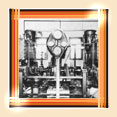Alberta Online Encyclopedia
|
|
|||||
 |
|||||
 |
 |
||||
 |
Multiple Message Wires The telegraph had quickly become an important business tool. By
1830, there was a network of over a thousand telegraph towers
working together throughout Europe. However, the rising popularity
This was particularly troublesome with the heavily trafficked line between the Stock Exchange branch and the nearby Central Telegraph Office. The Exchange would submit time-sensitive information along that one thin wire, hoping the telegraph operator could then relay it quickly to its destination to report important changes in share values. Josiah Clark, an employee of the Electric Telegraph Company, came up with a novel solution. Rather than sending outgoing messages across the wire, these could be placed on small cases and shot through a pneumatic tube (a tube of compressed air that could be controlled to carry items between two points). A tube was set up between the telegraph office and the Exchange. The use of the wire, then, could be designated to in-bound messages only. A year after his 1853 test, Clark saw his vision made reality when an underground tube was laid between the Exchange and the Telegraph Office. Overall, this device was so successful that another tube, running from a different branch office located further away, was installed in 1858. After that, there was an explosion of pneumatic tube delivery systems throughout England and France. By 1866, there were pneumatic tube networks also functioning in Austria, Italy, the United States, and even Brazil. These were subject to blockages, however, and to air leaks that would slow message delivery. The only sure solution lay in the development of wire set-ups that could handle multiple messages, called the duplex system. In 1872, an electrical engineer and sometime telegraph operator from Massachusetts by the name of Joseph B. Stearns became the first to create a successful duplex system. This type of line allowed for the simultaneous transmission of two messages—one in each direction—along the same wire. In 1862, ten years before Stearns’ invention, a young inventor
from Ohio by the name of Thomas Following Edison’s invention, the push was on to create systems that could send even more simultaneous messages. Among others, Elisha Gray from Barnesville, Ohio, and Alexander Graham Bell (born in Scotland but working from Brantford, Ontario, and Boston, Massachusetts) both ended up tinkering with the Harmonic Telegraph. Also known as the Musical Telegraph, this device transmitted messages via sound. Its success would depend on the operator’s ear, as he would have to pick out which messages were being delivered in what tone. Bell soon realized his invention could be used to send human vocalizations over a standard line. Gray ignored this innovation, seeing it as merely another turn of events in the quest to perfect telegraphy. In reality, however, it was the first faint signal that the telegraph would be replaced by a new kind of transmission technology. Besides, telegraph operators had a more immediate problem in the form of an invention that threatened to render their profession all but obsolete: the Auto-Transmission Hub. Copyright © 2004 Heritage Community Foundation and Telephone Historical Centre All Rights Reserved |
|
|||
 |
|||||



